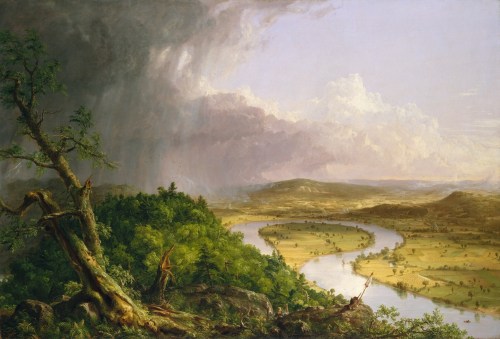Thomas Cole

View from Mount Holyoke, Northampton, Massachusetts, 1836
Thomas Cole (1801 – 1848)
Known as the influential founder of the Hudson River School of landscape painting, Thomas Cole created detailed views of nature and was a key figure in making landscape painting a respectable pursuit of American artists in the eyes of the public.
He was a religious man and a romantic, which was conveyed in the tone of his paintings and the moral and religious meaning he attached to his work. He was also one of the founders of The National Academy of Design in New York.
Cole was born in Lancashire, England, and apprenticed to an engraver of textile designs for calico. He came to Philadelphia in 1819 with his family and worked briefly for an engraver, shipped to the West Indies, and traveled by foot to join his family in Steubenville, Ohio. There he learned the rudiments of painting from an itinerant artist named Stein, and he began sketching along the Monongahela River.
He studied at the Pennsylvania Academy in 1823, and in 1825, moved to New York where he was discovered by John Trumbull, William Dunlap, and Asher Durand who saw his sketches of the Hudson River Valley and the Catskill Mountains in a shop window. They bought the painting, and his reputation was made. In 1836, he settled in the village of Catskill.
He spent several years in Europe and from English theater, developed a great interest in panoramas. He was not overly impressed with European art, being much more interested in what he saw and thought about in the United States. While in Europe, he made a plan for a monumental series of large paintings that would trace the evolution of civilization, and when he returned to America, the series was commissioned by collector Luman Reed. In 1835, Cole completed the work titled The Course of Empire, which is in the collection of the New York Historical Society.
In the 1830s, he was at the height of his powers, painting both landscapes and allegorical works and earning much money for them. His premature death from pneumonia was considered a great loss to America.
Source:
Michael David Zellman, 300 Years of American Art
Biography from the Archives of AskART.